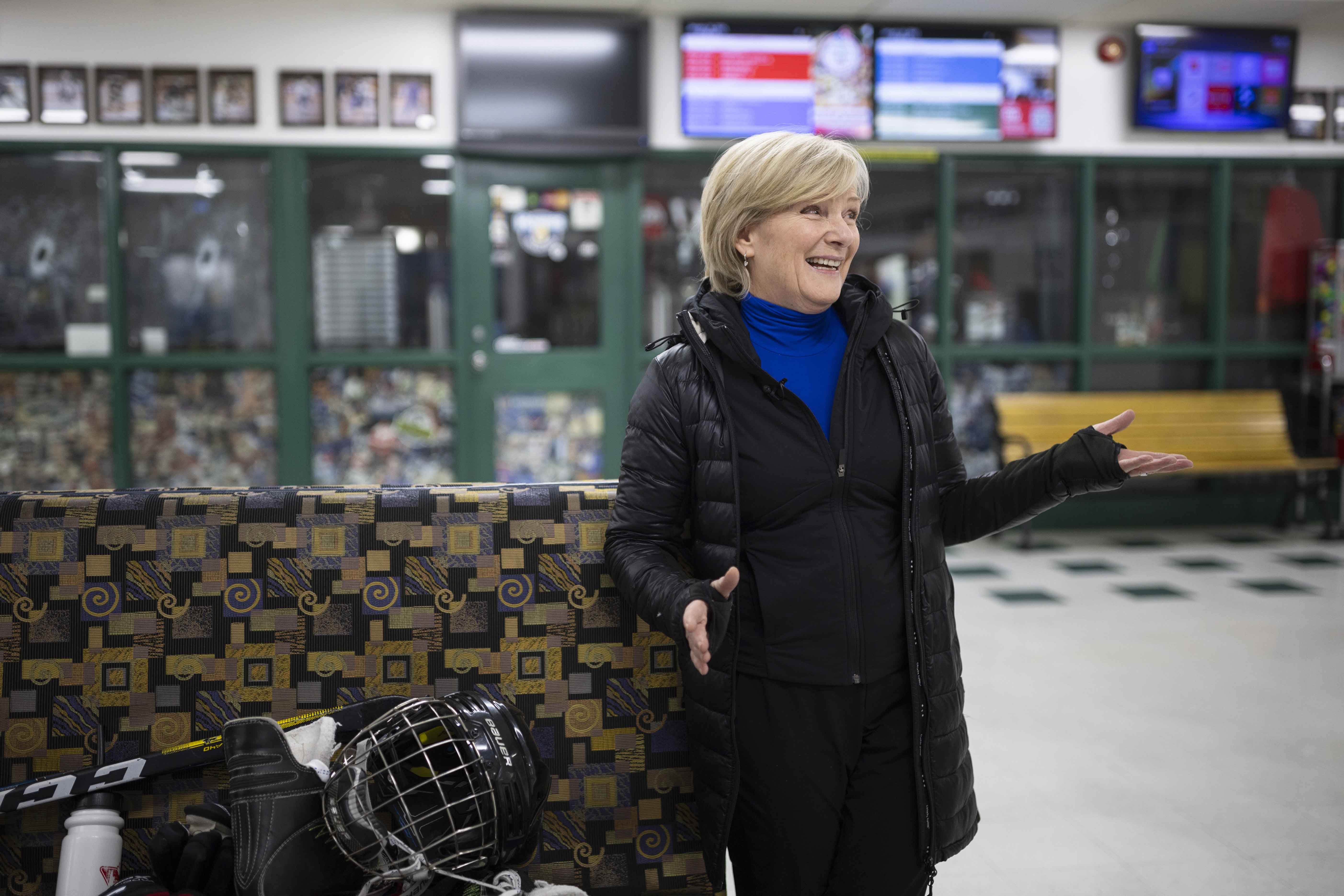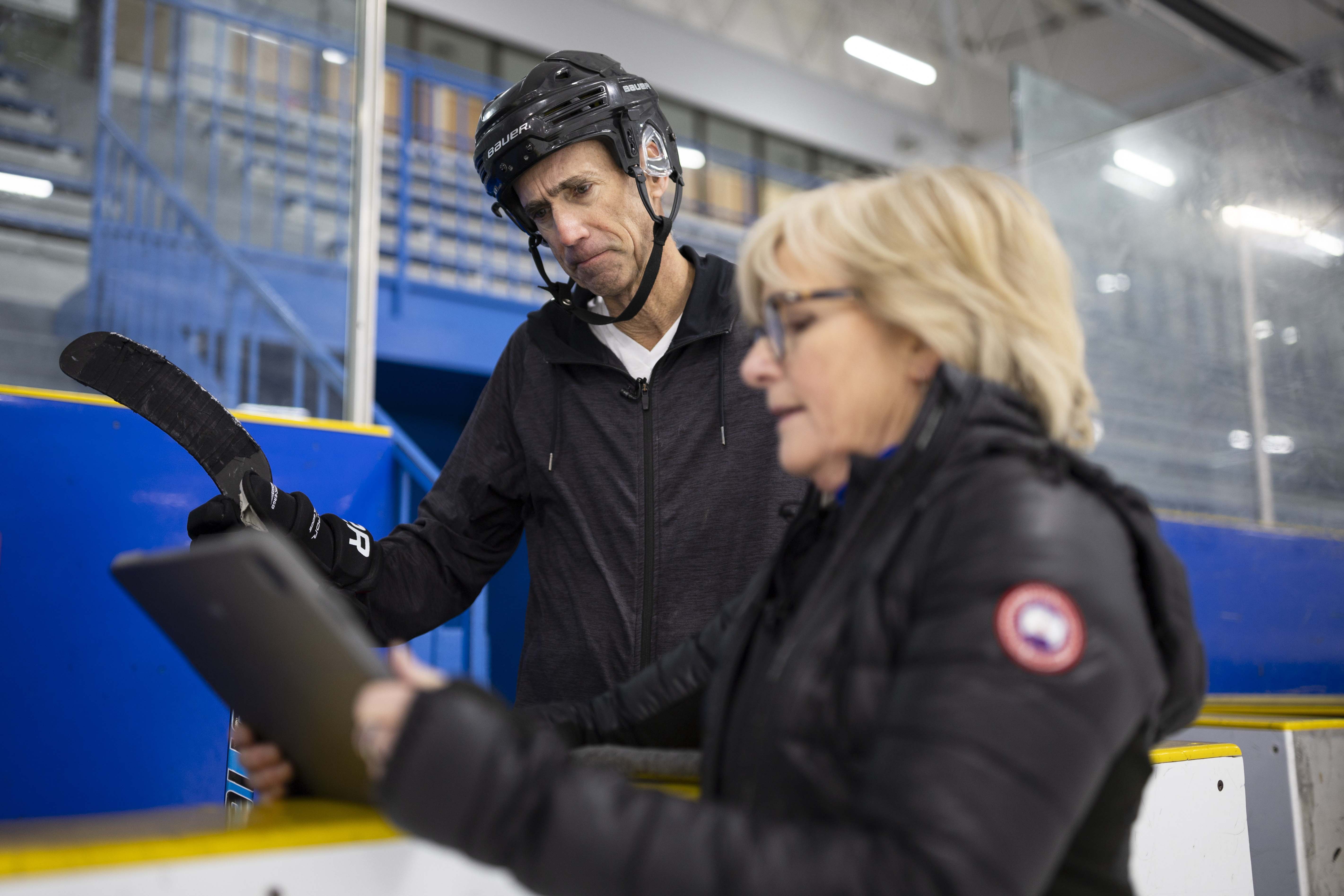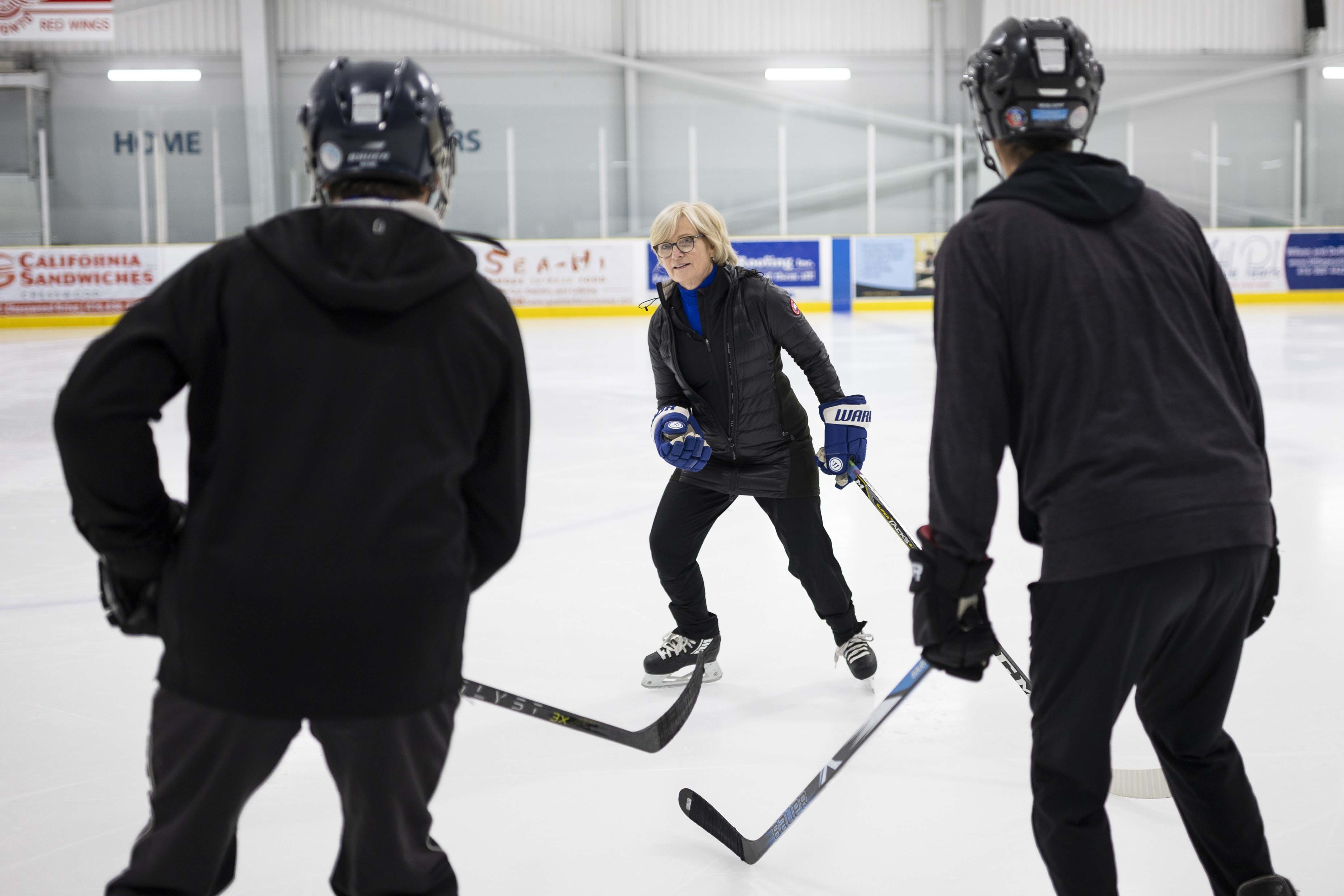My epiphany came while shaving to sports radio. Brian Boyle, a former NHLer, was recalling the skating lessons he received as a fringe member of the New York Rangers. His instructor? Barb Underhill, once an Olympic pairs figure skater for Canada. She took video of him skating in a straight line, and within four minutes, began diagnosing his inefficiencies. He went on to a long, productive career. “She’s a genius,” he said.
The absurdity of my own struggles flashed. Every summer, I sprint up hills in a ravine near my home to get in shape for the coming season of hockey. Why? Because I’ve passed 60, and my weekly pickup game is filled with the 25-year-old sons of the old guys. And most of the sons have had high-level training and skate with the power and grace of Willy Nylander. I, on the other hand, never played organized hockey, not even house league, as a youngster.
Why not learn to skate efficiently, instead of racing up hills in July, like Sisyphus in sneakers?
Barb Underhill skates with Paul Martini at the 1984 world championships.Ron Poling
I needed a genius. So I contacted the Tampa Bay Lightning, for whom Underhill currently works as a skating instructor, and asked them to pass on a message from me. And it wasn’t long before she telephoned, heard me out and amazingly, agreed to give me skating lessons. Pro bono. “I always love a challenge,” she said.
I peeked at Wikipedia. There’s a picture of Underhill where she’s about 15 feet in the air, her body perfectly under control. In person she’s a dynamo, five feet tall and 60 years old, and when she skates she’s effortless. Neither age nor gravity seem to bind her. She moves, man.
I brought along my buddy-since-childhood, Rob Fishbaum. Like me, Rob is mad for sports. When he was in high school, with his eye on a pro football career, he would stick his kid sister behind the wheel of the family Valiant, put it in neutral and push it around the streets of Bathurst Manor to build up his skinny legs. (He played varsity football at Guelph but was too slow for the pros.) And like me, he didn’t play organized hockey as a child. Also like me, he runs hills in July for hockey. In his case, a ski hill. He’s a maniac.
The Lightning have won two Stanley Cups with Underhill’s help and advice as an independent contractor. Her star pupil is the great Brayden Point. “For him, it was all about getting him in a balanced position – finding the sweet spot of the blade,” Underhill said. “Once he found it, he just took off.” The sweet spot is under the ball of the foot. Find it and it helps engage the right muscles. Then you’ll “pop.”
I felt certain I was capable of popping.
“You’re very efficient, very impressive. I can see you’ve done a lot of work. You’re very smooth. There’s not a lot of upper-body movement. You’re like, ‘Oh yeah, oh yeah, I’m cool.’”
And to me? “If I can get you to understand how to control your body and have your skates under you, you’re going to be smooth as silk.”
It occurred to me I might be too late. The mind is willing, but will it let the body know?
So I telephoned Daniel Gallucci, a clinical neuroscientist, to talk about muscle memory and brain plasticity. In older folks and any folks, really. Many people are trying to learn new skills or refine old ones. A musical instrument, an art form, a language.
“The ability to learn is constant throughout the life cycle,” he said.
But the brain “doesn’t care about your goals, your hopes, your dreams.” It cares about its own survival as an organism. It is content with the status quo. This is especially true as we age.
So the brain by its nature sets up hurdles. How to overcome?
Part of it is the mindset. The self-belief. Gallucci said he has encountered many people even at age 30 with a self-limiting belief structure about their ability to learn new things or adopt new tasks.
Part of it is the consistency and repetition. “Consistency over time is critical to creating the neuroplastic changes that we need,” he says.
During his training with Underhill, Sean sought out other expert help to see what neuroscience says about developing skills such as skating.
Gallucci has taken part in a project in which imaging machines showed how the brains of professional athletes are wired in real time. “The thing that makes an athlete an athlete when it comes to this sort of skill acquisition is the efficiency of movement.” The brain, he said, craves efficiency. Consistency drives the emergence of efficiency.
And you want to keep it fun. That activates reward centres in the brain, which makes it more likely your brain will adopt the behaviour.
Also, visualization helps. Watching, say, 10 minutes a day of good skating. He calls this “hacking the system.” “You can actually build the fibres [in neural networks] because large portions of the brain don’t know the difference between whether you’re doing it or not doing it.”
And the visualization continues when you sleep. You learn while you sleep. “When you’re trying to build skill acquisition, that mostly happens during sleep.” He likens this process to a tennis match between Rafael Nadal and Novak Djokovic. Among different parts of the brain, “there’s a banter at night that goes back and forth ... that solidifies the learning.”
Sleeping I can do.



We had three lessons, and the skating got in my blood.
Underhill describes her teaching style as intuitive. Each skater has different needs. Even in the NHL.
“I can see a player skate down the ice and immediately I think, ‘oh, he’s got a piano on his back.’ I can see it and I can feel it, almost.”
Her goal: “I’m trying to get you to a place where you look at me and say, ‘that felt good. Oh, I felt that.’ That’s the moment I wait for with my players. Because when it feels good, it’s generally right. And it can be repeated.”
We stood against the boards, on one leg, loading up our joints – hip, knee and ankle. The knee needs to be over the boot. The ankle needs to flex to make this possible. We held it, and bounced a little, till the glutes burned. Then we shifted to the other leg.
Unless my weight is over my leg, I won’t be able to load the joints.
The joints are springs, she said.
“I want you to press into the balls of your feet,” she said. “Pressing on the balls of your feet helps activate the core.”
At home I would hop from foot to foot, my weight on the sweet spot. We had a guest French bulldog one week who looked at me with concern.
“What are you doing, honey?” my spouse asked. “It’s after midnight.”
“I’m practising my ankle flexion.”
For at least two weeks I was on the ice early every morning. I was on the ice when the wind-chill hit minus-20, gliding on my outside edge. Sometimes I remembered to hinge at the hips and keep my chest up, or drive my knees forward, or press down into the ice, though rarely all three at the same time.
And I discovered others like me. A 33-year-old man taking lessons from a Russian fellow. A 72-year-old man who skated laps with a stick, but no puck, in an enviably fluid style. A woman in her 20s who had that little bounce, that jounce, in the crossover.
Ah, the crossover.
When I was 12, my mother gave me the gift of a week at summer hockey camp. That was the year we lost our house. Hockey camp was to make up for it. I remember they had us skate in a circle doing crossovers. When fall came and the outdoor rinks opened, I went regularly and did endless circles.
Underhill showed me a video of Erik Karlsson using his crossovers to pick up speed. Karlsson is one of her avatars. The quiet of his upper body, the way he lands each crossover on the front of each skate, his weight over top, is her ideal.
Another epiphany: In my Saturday game, the young guys use the crossovers not just to skate on a curve, but to accelerate. The old guys mostly don’t do that. In my daily skate I practised it, a double crossover this way with the puck, a double crossover that way. Working through that awkward stage.
Then I tested it out in the game, which was started by Globe and Mail reporters around 1984. John Allemang, one of our greatest former players (and surely our best prose stylist), once said we play with “rat-like intensity.” Someone dubbed the game the raison d’être.
I was playing defence, and went back for the puck. With no one around I launched into my double crossovers. My defence partner, Globe business columnist Tony Keller, went skating up ice and, in the midst of a double crossover of his own, called for a pass. I was loathe to give him the puck before I finished my second set of crossovers. I’m not sure anyone noticed the strangeness of this spectacle.
This is the part where I tell you how I showed Rob up in the Saturday game, and skated circles around the sons.
Alas, Erik Karlsson was not made in three lessons and some bouncing around the house. Boyle himself said he had 27 or 30 hours of lessons over a summer. In Underhill’s eyes, I became a little more fluid. A big improvement, she said. “You, too,” she told Rob.
I can’t say enough about Underhill’s kindness, generosity, teaching skill and patience. Between lessons we spoke and she went over video with me.
Did I pop? Yes, I did – doing crossovers while skating backward on the practice rink. It was not something Underhill and I worked on, though I believe I applied the principles she taught me. In certain daily exercises my core suddenly made its presence known – it didn’t text, it didn’t call, but there it was – and pressing down into the balls of my feet, in a short burst in a game, I surprised one of the young players and beat him to the puck.
His response was to throw me to the ice.
But I’m not done yet. I’m still working at it. My core is engaged and so am I. I can feel it coming. As the Green Bay Packers of my childhood used to say – We never lost a game. We just ran out of time.